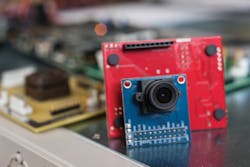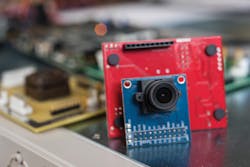Research and development/Camera design: Low-power, gesture-recognition camera is always on
Researchers at Georgia Institute of Technology (Georgia Tech; Atlanta, GA. USA; www.gatech.edu) have created an "always-on" camera that "wakes up" when it recognizes a specific human gesture - for example someone writing a "Z" in the air. Designed with a combination of low-power hardware and energy efficient image processing software, the always-on camera, which was primarily designed as a way to wake up other devices, is capable of watching for movement without draining batteries.
"Right now cameras are very hard to run on passive power just because they burn so much power themselves," says Justin Romberg, a professor in Georgia Tech's School of Electrical and Computer Engineering. "This combination of efficient signal processing and a novel hardware design lowers the power requirement and means that some of these other options to power it might be open."
The research, which was highlighted at the International Symposium on Low Power Electronics and Design (Aug. 8-10, 2016; San Francisco, CA) was sponsored by Intel Corp. (Santa Clara, CA, USA; www.intel.com) and the National Science Foundation (Arlington, VA, USA; www.nsf.gov). While reducing the frame rate of a camera plays a role in lowering power demands, to achieve the power savings needed for this project, the researchers programmed the camera to track motion in a more generalized way that still preserved crucial details about what was being tracked. That requires much less power to process than tracking individual pixels throughout the entire field of view.
Pixel-adding algorithm
"What this camera is actually looking at is not pixel values, but pixels added together in all different ways and a dramatically smaller number of measurements than if you had it in a standard mode," Romberg says.
"Simple motion detection is a well-studied area of research, and there are commercial products that support motion detection," says Arijit Raychowdhury, an associate professor in the School of Electrical and Computer Engineering. "But the problem is that a camera that can just detect motion - and not specific patterns in motion or gestures - is going to wake up more often, even when it doesn't need to."
Such a low-power camera could be useful in a range of applications, especially for camera systems in remote locations where efficiency is crucial. Other applications include specialized surveillance, robotics and consumer electronics with hands-free operation, and the researchers are already working on adding wireless functionality to transmit images and data with an antenna.
Source: http://b.gatech.edu/2e29FXZ
REFERENCE:
Anvesha A. et al., "A Light-powered, 'Always-On', Smart Camera with Compressed Domain Gesture Detection," International Symposium on Low Power Electronics and Design 2016.

